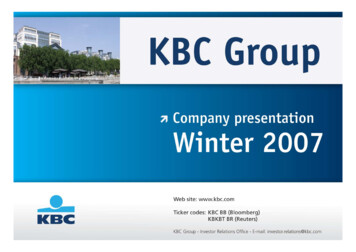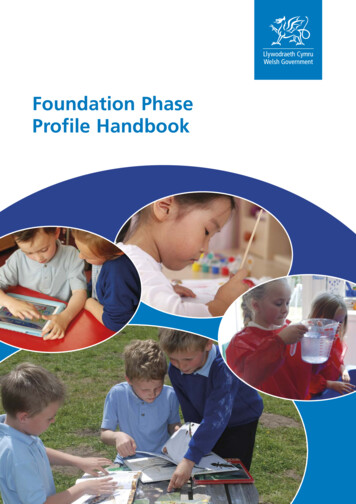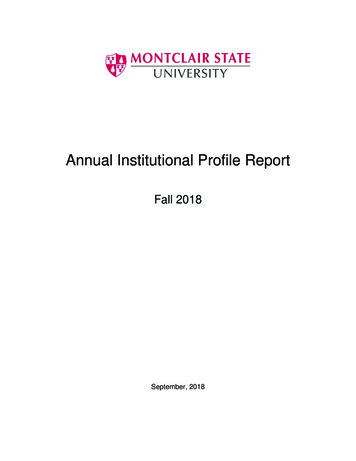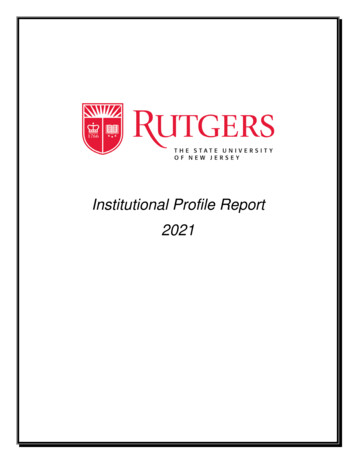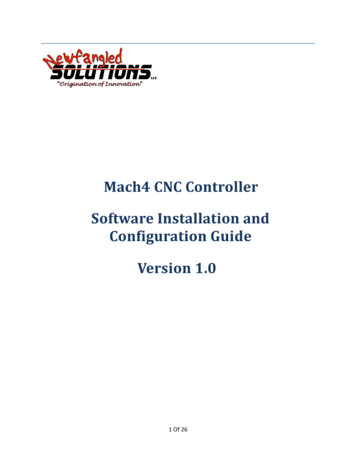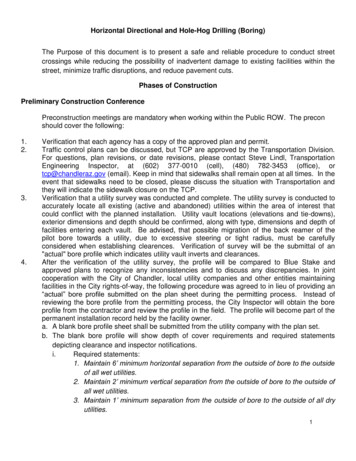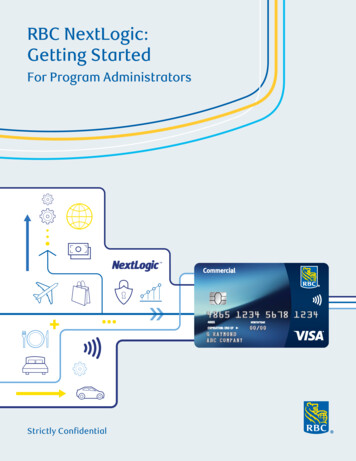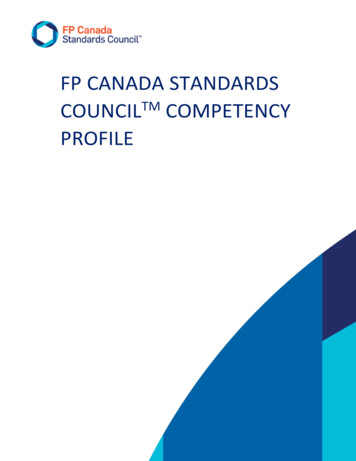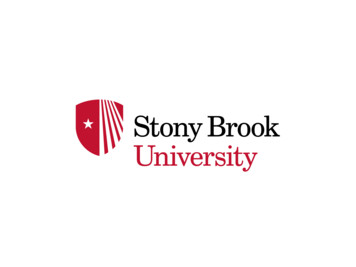
Transcription
2021 ANNUAL INSTITUTIONAL PROFILESubmitted toThe New Jersey Office of the Secretary of Higher EducationbyThe Office of Institutional ResearchSeptember 2021
Ramapo College of New JerseyTable of ContentsI. PROFILE OF RAMAPO COLLEGE OF NEW JERSEY . 2INSTITUTIONAL MISSION . 5INSTITUTIONAL VISION . 5VALUES STATEMENT . 5STRATEGIC PLAN GOALS AND OBJECTIVES . 6II. DATA BY CATEGORY . 8A. ACCREDITATION STATUS . 8LICENSE . 8INSTITUTIONAL ACCREDITATION . 8PROFESSIONAL ACCREDITATION . 8B. NUMBER OF STUDENTS SERVED . 9C. CHARACTERISTICS OF UNDERGRADUATE STUDENTS. 10MEAN SAT SCORES . 10ENROLLMENT IN REMEDIATION COURSES. 11DEMOGRAPHICS . 11STUDENTS RECEIVING FINANCIAL ASSISTANCE FROM VARIOUS SOURCES . 13NEW JERSEY RESIDENTS . 13D. STUDENT OUTCOMES . 14E. FACULTY CHARACTERISTICS. 15F. CHARACTERISTICS OF TRUSTEES OR GOVERNORS . 19G. PROFILE OF THE INSTITUTION . 21DEGREE AND CERTIFICATE PROGRAMS . 21H. MAJOR RESEARCH AND PUBLIC SERVICE ACTIVITIES . 24FACULTY ACCOMPLISHMENTS . 25I. MAJOR CAPITAL PROJECTS UNDERWAY IN FISCAL YEAR 2021. 35i
Ramapo College of New JerseyI. PROFILE OF RAMAPO COLLEGE OF NEW JERSEYImportant accolades for academic year 2020-2021 Ramapo College of New Jersey is named among the top in College Choice’s ranking of the“20 Best Colleges in New Jersey,” as of June 2021. Ramapo ranks as #1 among the ninepublic colleges in New Jersey and is ranked #3 overall, with Princeton University andStevens Institute of Technology in the top two spots. Ramapo ranked sixth in the 2020-2021 edition of the U.S. News & World Report amongpublic colleges and was #34 among all institutions in the Regional Universities Northcategory. Kiplinger’s Personal Finance list included Ramapo College in its top 100 “Best Values inEducation” list in 2019-2020. Ramapo College was determined by Buffalo Business First to be in the top 100 in the nationin its 2020 rankings of the country’s best public colleges. Ramapo College of New Jersey was included by The Princeton Review as one of 224 collegesin the 2020 “Best in the Northeast.” Ramapo College was designated as a Bronze “Military Friendly School” by the 2020-2021Guide to Military Friendly Schools. Money Magazine listed Ramapo College as seventh in the state in its 2020 “Best CollegesValue for Your Money” rankings. CondeNast Traveler named Ramapo College as one of the 50 Most Beautiful CollegeCampuses in America in July 2020. Ramapo College ranked #1 among all public and private colleges and universities in NewJersey by Niche in its announcement of the 2021 Best College Dorms in America. Nationally,Ramapo advanced in its ranking to the top 2%.Ramapo College of New Jersey is often mistaken for a private college. This is, in part, due to itsunique interdisciplinary academic structure; its size (i.e., Ramapo enrolled 6,042 students in Fall2020); and its pastoral setting in the foothills of the Ramapo Mountains on the New Jersey/NewYork border. Its designation as New Jersey’s “Public Liberal Arts College” by the Statelegislature advances the College’s commitment to affordable undergraduate and graduate liberalarts education.Ramapo College is located in Mahwah Township in northwestern Bergen County. The barrierfree campus occupies 300 acres. It was designated “Stigma Free” by the National Alliance on2
Ramapo College of New JerseyMental Illness in 2016. Facilities include general classrooms, laboratories, academic buildings,an administration building, a library, a Learning Commons Center, a center for fine andperforming arts, a sports and recreation center, campus life buildings, a spiritual center, athleticfields, dining halls, student apartments, and residence halls.On average over 91% of the incoming new students in the last five years indicated that Ramapowas either their first or second choice school. For the Fall 2020 semester, almost 67% of firstyear applicants were accepted. The average combined SAT score (critical reading and math) forregular-admit degree-seeking first-year students was 1149. The average combined SAT scorefor all degree-seeking first-year students who enrolled, including Educational Opportunity Fundand special admit students, was 1134.Ramapo College’s mission is focused on its four “pillars” of education: international,intercultural, interdisciplinary and experiential learning, all of which are incorporated throughoutthe curriculum and co-curricular activities. Organized into five schools offering 50undergraduate and graduate degree programs and 1 doctoral program, the College’s offeringsare complemented by lectures, performances, and off-campus experiences. The College offersBachelor’s degrees in the arts, business, the humanities, the social sciences, and the sciences, aswell as in professional studies such as nursing, social work, and teacher education. Eightprograms were offered in Academic Year 2020-2021, which lead to a Master’s degree: Masterof Arts in Educational Leadership (MAEL), Master of Science in Accounting (MSAC), Masterof Science in Contemporary Instructional Design (MCID) (originally the MS in EducationalTechnology (MSET)), Master of Science in Nursing (MSN), Master of Business Administration(MBA), Master of Arts in Special Education (MASE), Master of Social Work (MSW), andMaster of Science in Data Science (MSDS). In Fall 2020, Ramapo offered its first doctoralprogram, i.e., Doctor of Nursing Practice (DNP). The College has joint degree programs withRutgers Biomedical and Health Sciences – School of Health-Related Programs in ClinicalLaboratory Science and Medical Imaging Science. The College maintains articulationagreements with other participating institutions with programs in Biomedical Informatics,Chiropractic, Dentistry, Optometry, Osteopathic Medicine, Pharmacy, Physical Therapy,Physician Assistant, and Podiatric Medicine.An important key to the College’s strategy has been the building of partnerships with membersof the surrounding communities, the State, high schools, other colleges, and domestic andinternational corporations. Faculty and staff have been successful in obtaining major grants fromState, national, and international sources to support scholarship, partnerships, curricularimprovements, seminars, and conferences. Their efforts have brought recognition in the form ofFulbright Awards and Guggenheim Fellowships, major National Science Foundation andNational Endowment for the Arts grants, international presentations, and numerous prestigiousawards.3
Ramapo College of New JerseyLibrary Rehabilitation and Learning Commons AdditionOne of the major projects, for which planning began in Spring 2018, was the transformation ofthe existing George T. Potter Library into a vibrant “Learning Commons.” This project wasinitiated based on the expectation that students will learn and study more effectively byincorporating new technologies and methods of creating scholarship.A successful Learning Commons is expected to provide a variety of flexible learningenvironments and high-quality experiences for both individual and group study while co-locatinglibrary, information technology, and other academic support expertise. To satisfy these expressedneeds, the library renovation and addition will include spaces on all floors for both individualand collaborative learning and feature several new student and faculty-orientated services,including the College’s Information Technology Services, a newly-created makerspace, anexpanded Special Collections, and enhanced space for Reference and Research Services.In addition to two informational literacy classrooms, the Learning Commons will add overtwenty technology-rich group study rooms to be used for screening films, conducting grouppresentations, one-button studio recording, video conferences, and remote learning. Since libraryusers are often immersed in their work for hours on end, a wide variety of comfortable seatingoptions will address user preferences for lounge, study, and computer-intensive activity.Construction on the newly named Peter P. Mercer Leaning Commons facility began early Spring2020 with a groundbreaking ceremony that was attended by Board of Trustee members, membersof the President’s Cabinet, faculty, staff, and students. The original building was to get athorough replacement and contemporizing of its aging systems, including upgrades to thebuilding envelope to address thermal performance and water infiltration issues and increaseaccess to daylight and views, while maintaining the building’s slate panel facade, which is aniconic feature of the campus’ historic core buildings. The demolition of the existing librarybuilding took place in January 2020, and the library is expected to open in Fall 2021. TheLearning Commons will not only enhance the College’s current exceptional academiccurriculum but will be a featured component of the College’s educational mission for manydecades.While awaiting the completion of the Learning Commons, the existing library was temporarilyrelocated on the first and second floors of Linden Hall as of January 2019. Almost all regularservices are provided in the temporary location, including circulation, reference services,microfilm reading, interlibrary loan and more. Furthermore, the main features of the temporarylibrary include the following: approximately 270 study seats including group study rooms; reading room seating;4
Ramapo College of New Jersey two computer classrooms;excellent wi-fi and availability of loaner laptops;access to online resources such as databases, journals, e-books, and newspapers; information literacy instruction sessions with librarians; all research help services offered in person, as well as by phone, email, chat, or text; all circulation desk services including checkout and course reserves; a 10,500-volume core book collection; best sellers collection and new books display; current periodicals; and the ability to request books from interlibrary loan and to request archival materials.INSTITUTIONAL MISSIONRamapo College is New Jersey’s Public Liberal Arts College, dedicated to providing students astrong foundation for a lifetime of achievement. The College is committed to academicexcellence through interdisciplinary and experiential learning and international and interculturalunderstanding. Ramapo College emphasizes teaching and individual attention to all students.We promote diversity, inclusiveness, sustainability, student engagement, and communityinvolvement.INSTITUTIONAL VISIONAs the region’s premier Public Liberal Arts College, Ramapo College of New Jersey preparesstudents to be successful leaders for a changing world through its distinctive commitments tohands-on learning and faculty-student mentoring.VALUES STATEMENTRamapo College is the Public Liberal Arts College of the State of New Jersey. The work of theCollege and its members is conducted with integrity. Our values are as follows: Teaching, learning, and mentoring – we are actively engaged in and out of the classroom. Developing the whole person – we are scholars, we are creators, we are local and globalcitizens, and we are individuals.Respecting each other and our environment – we are an open, inclusive, supportive, and 5
Ramapo College of New Jerseysustainable community.STRATEGIC PLAN GOALS AND OBJECTIVESGOAL 1 - INCREASE STUDENT SUCCESS AND STUDENT ENGAGEMENT Objective 1.1: To enroll diverse students who actively contribute to campus life. Objective 1.2: To increase the enrollment of residential first-year students. Objective 1.3: To increase the number of students transferring from partner institutions. Objective 1.4: To increase the four-year graduation rate. Objective 1.5: To increase the six-year graduation rate. Objective 1.6: To increase its first-year retention rate. Objective 1.7: To support and develop a diverse, highly qualified, engaged, andaccessible faculty through activities centered on teaching, learning, and advising;scholarship and creative work; and service and college governance. Objective 1.8: To facilitate student success, in terms of completion and employment, viaexperiential learning. Objective 1.9: To demonstrate the value of a Ramapo College degree through metricsassociated with employment and educational attainment. Objective 1.10: To increase students’ academic, personal, social, and civic engagementthrough enhanced curricular, co-curricular, and extra-curricular programming.GOAL 2 - CULTIVATE AND SUPPORT EQUITY, DIVERSITY, AND INCLUSION Objective 2.1: To deliver and promote curricular, co-curricular, extra-curricular, anddevelopment programs that strive to eliminate stereotypes and negative biases,demonstrate a commitment to diversity and promote self-awareness, an examination ofmultiple perspectives, and respect for others. Objective 2.2: To close the achievement gap by increasing retention and graduation ratesof students by student type and race/ethnicity. Objective 2.3: To recruit employees who reflect and are committed to diversity andinclusiveness.6
Ramapo College of New Jersey Objective 2.4: To foster collegiality and collaboration by advancing recommendations ofthe 2017 Report of the Task Force on Shared Governance.GOAL 3 - ADVANCE INNOVATION AS THE COLLEGE'S PROMISE AND OBLIGATION TOITS STUDENTS, COMMUNITY, AND THE STATE OF NEW JERSEY Objective 3.1: To facilitate curricular innovation and to ensure that curriculum remainsfounded in the liberal arts, relevant, attuned to students’ needs, and responsive to theeconomic environment. Objective 3.2: To strengthen mutually beneficial partnerships with alumni, parents,friends, business, professional organizations, as well as community and governmentagencies. Objective 3.3: To optimize technology and software to automate functions and expandthe capacity of existing systems for reporting and assessment. Objective 3.4: To cultivate the next generation of higher education leaders through thedelivery of an internal Leadership, Development and Performance (LDP) program.GOAL 4 - IMPROVE LONG-TERM FINANCIAL STRENGTH Objective 4.1: To address systemic long-term deficits created by the reliance on Statefunding and practical limitations of increasing tuition. Objective 4.2: To strengthen the College’s presence in Trenton to ensure it receives dueconsideration in decisions affecting higher education. Objective 4.3: To address space allocation, its optimization, and deferred maintenance,in light of enrollment and economic trends. Objective 4.4: To publicly position the College through advocacy, marketing, and publicrelations as the premier public college in the region. Objective 4.5: To leverage relationships with alumni, parents, corporations, and friendsto advance the College’s visibility. Objective 4.6: To enhance financial strength through increasing support from theFoundation. Objective 4.7: To align fundraising efforts for capital, operations, student access, andgrant initiatives with annual College priorities.7
Ramapo College of New JerseyII. DATA BY CATEGORYA. ACCREDITATION STATUSLICENSERamapo College of New Jersey is licensed by the State of New Jersey.INSTITUTIONAL ACCREDITATIONRamapo College of New Jersey is accredited by the Middle States Commission on HigherEducation (MSCHE), 3624 Market Street, 2nd Floor West, Philadelphia, PA 19104.PROFESSIONAL ACCREDITATIONAccreditation Commission for Education in Nursing (ACEN)Association to Advance Collegiate Schools of Business (AACSB)Council for the Accreditation of Educator Preparation (CAEP)Council on Social Work Education (CSWE)And, although it is not an accreditation, the American Chemical Society (ACS) approvesprograms.8
Ramapo College of New JerseyB. NUMBER OF STUDENTS SERVEDRamapo College served almost 7,000 studentsduring fiscal year 2020. In Fall 2020, 6,042students were enrolled, while in Spring 20215,622 students were enrolled at RamapoCollege.In Fall 2020, 7,980 applications weresubmitted by prospective first-year students,and almost 67% (5,334) were admitted to theCollege. Of those admitted, roughly 19% ( 997)subsequently enrolled.Table II.B.1Undergraduate Enrollment by Attendance Status: Fall 2020Full TimeNumberPercent4,72087.2Part TimeNumberPercent69212.8Total5,412Table II.B.2Graduate Enrollment by Attendance Status: Fall 2020Full TimeNumberPercent24438.7Part TimeNumberPercent38661.3Total630Table II.B.4Unduplicated Enrollment: FY 2020UndergraduateGraduateTotalNumberCredit ,0899
Ramapo College of New JerseyC. CHARACTERISTICS OF UNDERGRADUATE STUDENTSOver 88% of the 997 new students enrolled in Fall 2020were regular admit, while almost 10% wereEducational Opportunity Fund (EOF) students.Undergraduates were tested using the Accuplacer todetermine if they needed any remediation in the areasof computation, algebra, writing or reading. Overall,7% of all undergraduate students were enrolled in atleast one remedial course. Among the new full-timestudents, 33% required remediation in at least one area.The need for remediation was higher for computation(21%) than for writing (almost 10%), algebra (over4%), and reading (almost 6%).MEAN SAT SCORESTable II.C.1Mean Math and Evidence-Based Reading & Writing (ERW) SAT Scoresfor First-Time First-Year Students by Admission Status: Fall 2020Admission StatusSAT ScoreFULL-TIME STUDENTSRegular Admits572.7EOF Admits512.2Special Admits488.3All Admits565.1MathReading & WritingNSAT ScoreN7729412878573.6515.4495.8566.37729412878Math and Reading & Writing scores were not available for 99 students.Please note that, because of small numbers (one part-time first-time first-year student), results are notshared here.10
Ramapo College of New JerseyENROLLMENT IN REMEDIATION COURSESTable II.C.2aTotal Undergraduate Enrollment in Remediation Courses: Fall 2020Total UndergradsUndergrads in 1 RemediationCoursesPercent of Total5,4123807.0Table II.C.2bTotal First-Time, Full-Time Student Enrollment in Remediation Courses: Fall 2020Total FTFT StudentsFTFT Students in 1 Remediation CoursesPercent of Total99532833.0Table II.C.2cFirst-Time, Full-Time Enrollment in Remediation Coursesby Subject Area: Fall 2020Subject AreaComputationAlgebraReadingWritingNumber of FTFT EnrolledPercent of FTFT Enrolled20944589821.04.45.89.8DEMOGRAPHICSIn Fall 2020, 6,042 students enrolled at Ramapo College of New Jersey. Of those, almost90% (5,412) were undergraduates. Over 87% of undergraduates were enrolled full-time.Almost 58% of undergraduates were female and, among those who provided informationregarding race/ethnicity, approximately 58% were White Non-Hispanic. In fact, minoritiesaccounted for almost 39% of the population, and 87% of all undergraduates were betweenthe ages of 18 and 24. A large proportion of undergraduates (over 94%) were from NewJersey, almost 44% of whom were from Bergen County.11
Ramapo College of New JerseyTable II.C.3aUndergraduate Enrollment by Race/Ethnicity and Attendance Status: Fall ispanicAsian*American 12100.0* Asian includes Pacific Islanders.** Unknown includes two or more races.Table II.C.3bUndergraduate Enrollment by Sex and Attendance Status: Fall le II.C.3cUndergraduate Enrollment by Age and Attendance Status: Fall 2020Age 1818-1920-2122-2425-2930-3435-3940-4950-6465 .05.81.70.61.20.80.50.0100.012
Ramapo College of New JerseySTUDENTS RECEIVING FINANCIAL ASSISTANCE FROM VARIOUS SOURCESDuring FY 2020, undergraduates at Ramapo received financial aid from a variety of Federal,State, and institutional programs. Almost two-thirds of the aid (i.e., 64%) came from Federalsources.Table II.C.4Students Receiving Financial Aid from Federal-, State-, and Institution-FundedPrograms: AY 2019-20Program# of RecipientsDollars ( ) 42-1,034.62FEDERAL PROGRAMSPell GrantsCollege Work StudyPerkins LoansSEOGPLUS LoansStafford Loans (Subsidized)Stafford Loans (Unsubsidized)SMART & ACG or otherCARES Act- HEERF Student AidSTATE PROGRAMSTuition Aid Grants (TAG)Educational Opportunity Fund (EOF)Other State Programs (OSRP,NJ-GIVS, WTC, etc.)Distinguished ScholarsUrban ScholarsNJ STARSNJCLASS LoansINSTITUTIONAL 9,997,00008,068.60--NEW JERSEY RESIDENTSTable II.C.5aFirst-Time Undergraduate Enrollment of New Jersey Residents: Fall 2020State ResidentsNon-State ResidentsTotal% State Residents9623599796.513
Ramapo College of New JerseyTable II.C.5bTotal Undergraduate Enrollment of New Jersey State Residents: Fall 2020State ResidentsNon-State ResidentsTotal% State Residents5,0983145,41294.2D. STUDENT OUTCOMESThe six-year graduation rate for the Fall2014 cohort was 72% (72% of first-time, fulltime, degree-seeking students who initiallyenrolled in 2014 graduated by August 2020).The one-year retention rate (“third-semesterretention rate”) for the Fall 2019 cohort isabout 85% (85% of first-time, full-time,degree-seeking students who initiallyenrolled in Fall 2019 re-enrolled in Fall2020).Table II.D.1Four-, Five-, and Six-Year Graduation Rates by Race/Ethnicity: Fall 2014Cohort of First-Time, Full-Time Degree/Certificate-Seeking aduation .460.5Five-YearGraduation .670.3Six-YearGraduation .972.1* Other includes American Indians, Native Hawaiian and Pacific Islanders, 2 or More Races, and Unknown.14
Ramapo College of New JerseyTable II.D.2Third-Semester Retention Rates of First-Time Undergraduates byAttendance Status: Fall 2019 to Fall ads1NumberRetained1PercentRetained100.0E. FACULTY CHARACTERISTICSIn Fall 2020, 215 full-time faculty and 284part-time and adjunct faculty taught 6,042students at Ramapo College. Of the 215 fulltime faculty members, approximately 95%were tenured, 53% were female, and almost66% were White Non-Hispanic. Almost 94%of full-time faculty members possess adoctorate or a terminal degree. The studentfaculty ratio is 16 to 1, and the averageundergraduate class size is about 21.Table II.E.1Full-Time Faculty by Race/Ethnicity, Sex, and Tenure Status: Fall 2020Race/EthnicityTenure StatusWhite Non-HispanicTenured and Tenure-TrackProfessorsAssociate ProfessorsAssistant ProfessorsAll OthersNon-TenuredProfessorsAssociate ProfessorsAssistant ProfessorsAll OthersTotal 00.000711410.00.05.00.7100.015
Ramapo College of New JerseyTable II.E.1Full-Time Faculty by Race/Ethnicity, Sex, and Tenure Status: Fall 2020(continued)Race/EthnicityTenure Tenured and Tenure-TrackProfessorsAssociate ProfessorsAssistant ProfessorsAll OthersNon-TenuredProfessorsAssociate ProfessorsAssistant ProfessorsAll 0.00.00.00Total 100.00020330.00.06.10.0100.0HispanicTenured and Tenure-TrackProfessorsAssociate ProfessorsAssistant ProfessorsAll OthersNon-TenuredProfessorsAssociate ProfessorsAssistant ProfessorsAll OthersTotal HispanicAsian*Tenured and Tenure-TrackProfessorsAssociate ProfessorsAssistant ProfessorsAll OthersNon-TenuredProfessorsAssociate ProfessorsAssistant ProfessorsAll OthersTotal Asian** Asian includes Pacific Islanders.16
Ramapo College of New JerseyTable II.E.1Full-Time Faculty by Race/Ethnicity, Sex, and Tenure Status: Fall 2020(continued)Race/EthnicityTenure StatusAlienTenured and Tenure-TrackProfessorsAssociate ProfessorsAssistant ProfessorsAll OthersNon-TenuredProfessorsAssociate ProfessorsAssistant ProfessorsAll OthersTotal AlienTwo or More RacesTenured and Tenure-TrackProfessorsAssociate ProfessorsAssistant ProfessorsAll OthersNon-TenuredProfessorsAssociate ProfessorsAssistant ProfessorsAll OthersTotal Two or More RacesUnknownTenured and Tenure-TrackProfessorsAssociate ProfessorsAssistant ProfessorsAll OthersNon-TenuredProfessorsAssociate ProfessorsAssistant ProfessorsAll OthersTotal .017
Ramapo College of New JerseyTable II.E.1Full-Time Faculty by Race/Ethnicity, Sex, and Tenure Status: Fall 2020(continued)Race/EthnicityTenure StatusMaleNPercentFemaleNPercentTotalNPercentGRAND TOTAL (COMBINED TOTAL OF ALL RACE/ETHNICITIES)Tenured and Tenure-TrackProfessors3433.73328.967Associate Professors4140.65043.991Assistant Professors2120.82622.847All iate Professors00.000.00Assistant Professors55.043.59All Others00.010.91GRAND 5100.0Table II.E.2Percentage of Course Sections Taught by Full-Time Faculty: Fall 2020Total Number ofCourse Sections1052Courses Taught ByFull-Time FacultyNPercent62559.4Courses Taught ByPart-Time FacultyNPercent36334.5Courses Taught ByOthers*NPercent646.1* Others includes full-time administrators and teaching assistants.Table II.E.3Ratio of Full-Time to Part-Time Faculty: Fall .9N499TotalPercent100.018
Ramapo College of New JerseyF. CHARACTERISTICS OF TRUSTEES OR GOVERNORSPer New Jersey statute, the members of theBoard of Trustees are appointed by theGovernor with the advice and consent of theSenate. The Board of Trustees recommendspotential new members to the Governor inaccord with its Bylaws and CommitteeCharter, which state in pertinent part, “ThePublic Members shall be recommended forthe expertise and experience which they cancontribute to the mission of the College andshould be representative of the diversity ofthe state,” and “In carrying out thisresponsibility, the NominationsandGovernance Committee of the Board ofTrustees shall seek individuals with skillscomplementary to the range of expertiseamong existing members. Potential membersshall be of diverse backgrounds.”Table II.F.1Race/Ethnicity and Sex of Trustees*: Fall Percent91.78.3000.00.0100.0*Race/Ethnicity of the alt
in its 2020 rankings of the country's best public colleges. Ramapo College of New Jersey was included by The Princeton Review as one of 224 colleges in the 2020 "Best in the Northeast." Ramapo College was designated as a Bronze "Military Friendly School" by the 2020-2021 Guide to Military Friendly Schools.
